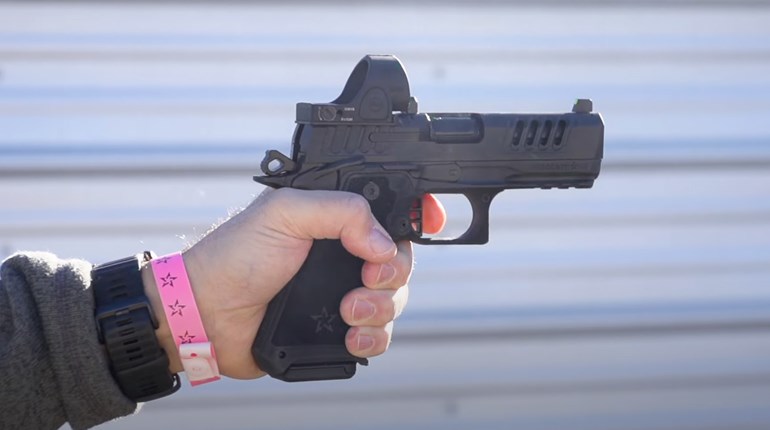
Clearing rooms by yourself is hard. Clearing rooms with a partner can be much easier, especially if you’ve put some thought into it (and had a bit of training, too). Now, a partner doesn’t necessarily have to mean your spouse or significant other. It could be a close friend, an adult child, parent, co-worker or other person with whom you’ve cultivated a rather close relationship. Since you spend the majority of your life in your home or at work, it is more likely to be your spouse or perhaps a co-worker, but don’t necessarily discount working as a team because you’re single or work from home.
In general, it’s a better idea to hunker down and let the professionals handle ensuring your house is clear in the event of a break-in. The police have training, a radio, backup and quite often a partner. But, it’s not always going to be that simple. What happens if you’re in the basement of your home doing laundry, with your children asleep upstairs, when you hear someone crashing down the door? Or, even simpler, you could be awakened at 2 am to an odd thump somewhere in the house.
Homeowners know that houses love to make weird noises at odd hours, and while a known intrusion should automatically trigger a 911 call, you’ll not make friends calling the police every time something goes bump in the night. There are many possible scenarios where you might want to leave the safety of a secured room to move through the house in search of a loved one or simply to confirm that something fell off the kitchen counter.
Clearing your house with a partner has numerous advantages. You’ve got double the eyes, half the area to watch and (ideally) twice the firepower. Being able to cover each other while negotiating open doorways and dangerous spaces provides benefits unachievable alone. However, it also presents difficulties that might not be readily apparent, something I learned when taking a “Team Tactics for Two” class at Gunsite Academy.
Plan
You know what makes things a lot easier? Having a plan ahead of time. While there’s obviously no way to prepare for all potential scenarios, there’s plenty we can do ahead of time. In your own home, identify blind spots and figure out ways to eliminate or lessen them. Work out simple plans for the places you go most often—supermarkets, box stores, restaurants and such. While you can’t plan for every convenience store and gas station, you know the places you visit most often in your daily life. Knowing alternate exits and maybe even (discreetly) measuring distances could serve as critical intel.

One important point I hadn’t considered was brought up in the Team Tactics class: While you and your partner should come up with signals and code words together, should your partner be less-than-enthusiastic about it, letting them work out various aspects of the plan gives them a very real sense of ownership and should hopefully engage them more fully. Simply handing your partner a sheet of hieroglyphics, acronyms and Xs and Os and expecting them to memorize everything might not go as well as you think. A plan ignored might as well not exist.
Sheriff Jim Wilson was kind enough to lend some of his experience to this class, and participated in one of the demonstrations where the importance of code words was stressed. As a peace officer, he had worked out a code with his partner where, should he be taken hostage by a criminal, his partner would address him using the wrong name. That was the signal for him to drop to the ground immediately so that the partner had a clear line-of-fire to the bad guy. Wilson and one of the instructors demonstrated this for the class, and it drove home just how well a little planning in advance of a potential threat could work.

Movement
First and foremost, safety is absolutely paramount. When proceeding as a team, it is vital to make sure there are no inadvertent muzzle issues. Being aware of your partner’s location is critical, as is the direction in which you are pointing the muzzle of your firearm. Should one or both of you have a rifle or shotgun, the positioning of your partner shouldn’t get in the way of bringing your longarm to a ready position.
Proceeding through doorways is another area where having a partner requires advance planning. We’ve all seen videos where two bad guys (or two good guys) try to negotiate the same doorway at the same time (often for comic effect). Doorways are terrible places to be when there might be someone looking to do you harm, and you want to proceed through them as fast as possible, while minimizing the ability of a criminal to attack while you’re moving and vulnerable.
While having a plan is important, don’t overthink. While traversing some of the shoothouse scenarios with my partner, we’d start making elaborate diagrams and multi-step plans before entering the “house”—only to be reminded by instructors to keep it simple: Decide who’s going to lead the entry, and then proceed accordingly. Whoever goes in first, the partner follows accordingly. If the first team member goes left, the partner goes right. Overly complex plans require more processing than simple ones, and when negotiating potentially dangerous terrain, that’s extra brainpower you could use elsewhere.
Communication
Possibly the most important component when working with a partner is communication. When making entry into a room full of unknowns, having two sets of eyes means you can divide up the scanning—except it’s meaningless if you don’t exchange information. Seeing an open doorway that might have someone standing in or near it is important information. It should be acted upon swiftly, but only after informing your partner.
In one of the force-on-force scenarios, an attacker walked past my partner and me as we strolled down a quiet country road. I noticed a knife in his back pocket, and was mentally cataloging it when he turned around with a gun in his hand, demanding our money. Had I mentioned the knife to my partner, we would both have been on alert, and might have been able to leave the area before the crook put his plan into action.

Communication is especially important when a threat is engaged. One thing became crystal-clear during the force-on-force scenarios: Adrenaline levels go through the roof in situations like this, especially if there’s a loved one at risk. When the balloon goes up, if there’s gunplay in which you are not participating, it’s going to be nearly impossible to tell if it’s your partner doing the shooting, the bad guy or both. Simply calling out “threat” while engaging alerts your partner that things are about to happen.
Act
It sounds simple, doesn’t it? If there’s a bad guy, do something. However, that needs to be tempered with both communication with your partner—if time permits—as well as other safety considerations. If you’re entering a room, and you spy a threat, rushing to engage while standing in the doorway exposes you to danger. Act with purpose, but be mindful of other potential hazards.
In the aforementioned scenario, with the potential mugger walking past my partner and me with a knife in his back pocket, I fixated on the knife, waiting for a running attack (he had walked several dozen feet down the road ahead of us). When he turned with the gun in his hand, I hesitated for what seemed to be an eternity—until my partner acted quickly and ended the threat. Be ready for anything, and don’t let one possible danger blind you to others.
Don’t forget: Leaving the area is also an action in and of itself. In another force-on-force scenario, one of the other teams did exactly that in a restaurant scenario. A bad guy came in, started an altercation with one of the “employees,” and when the bad guy produced a pistol, the team sprinted for the exit. They had planned this ahead of time, put their plan into action instantly and exited the restaurant without injury or getting involved in what could be a dangerous situation. Getting out of Dodge may not work for every situation, but don’t discount running if you can.
Put it all Together
Have a plan. Move with purpose. Communicate with your partner. Act decisively. This is the path to successfully negotiating unknown dangers. All of it can be practiced at home, and a good deal can be practiced in your daily life in the places you frequent most often. You know the layout of your house, the local box store and other places you frequent on a regular basis. Figure out how to get out should something bad happen, how to react if you can’t leave and share this with your partner.
The mechanisms of how you might clear a structure are difficult, yes. Discussing basic concepts ahead of time and having a few basic defensive plans in mind isn’t. Code words can be figured out now, in the comfort of your home, so should you find yourself in a scenario that looks like it might go bad, simply using the code for “let’s get out of here immediately” is crystal-clear and acted upon instantly.
It could be something as simple as you and your spouse deciding that “Circus” is your word for exiting a restaurant immediately, as opposed to saying, “Hey, there’s a group of people arguing at the bar on Long Island Ice Tea night, and I would like to exit right this second so we don’t get needlessly involved in a 10-person fracas.” The KISS concept (Keep It Simple, Stupid) is always in play—make sure your code words are simple, unlikely to come up in normal conversation and acted upon with great haste.

Train
While a good portion of the steps above can be accomplished between you and your partner, putting those plans into action and testing how well you communicate should take place in the presence of qualified instructors. There’s a lot of value in force-on-force scenarios to really open your eyes to deficiencies in your plan, help you sharpen your communication skills and assist you in acting decisively and moving with purpose.
While you might have a rock-solid plan with which your partner is in 100-percent agreement, it’s difficult to safely and effectively put it to the test on your own. Sure, you and your spouse could (and should) periodically walk through your home to figure out the most effective means to check things quickly and safely, but introducing a bad actor in the equation takes it to the next level. If there’s a firearm or firearms in your home-defense plan, it’s imperative to know you can operate them effectively, move safely while presenting them and, equally important, when to get out and wait for law enforcement.
Facilities offering dedicated courses for couples or teams can help sharpen skills, refine plans and spot deficiencies. I know I came away from Gunsite’s Team Tactics course knowing several areas where I need to improve, and even some of the folks in the course with law enforcement backgrounds learned something.
In the end, we’re all responsible for our own safety. Whether you’re in your own home, out to dinner at a local restaurant, shopping at the grocery store or even out somewhere new, having a plan to deal with problems is a smart idea. Talking the plan over with your partner and letting them work with you to refine it gives them ownership and confidence. Lastly, the safest and most effective way to test your plan in action is with qualified instructors. No matter how tough you think you are, you’re more efficient as a team.



































